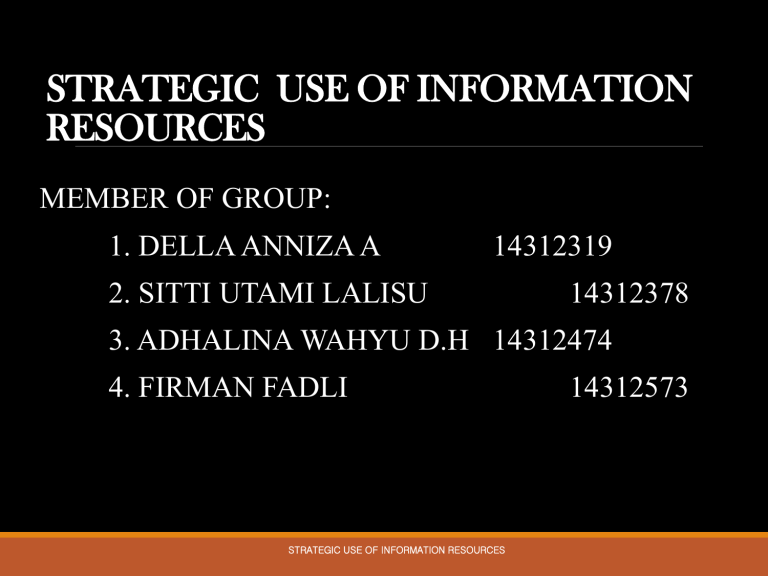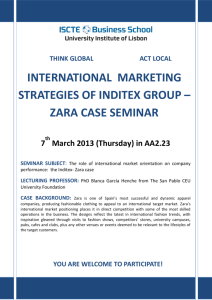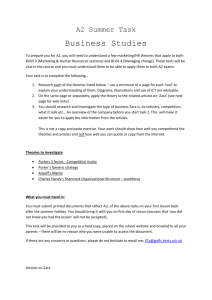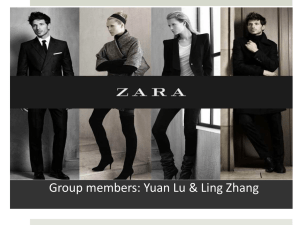
STRATEGIC USE OF INFORMATION RESOURCES MEMBER OF GROUP: 1. DELLA ANNIZA A 14312319 2. SITTI UTAMI LALISU 14312378 3. ADHALINA WAHYU D.H 14312474 4. FIRMAN FADLI STRATEGIC USE OF INFORMATION RESOURCES 14312573 TOPIC OUTLINES 1. EVOLUTION OF INFORMATION RESOURCES 2. INFORMATION RESOURCES AS STRATEGIC TOOLS 3. INFORMATION RESOURCES CAN BE USED STRATEGICALLY STRATEGIC USE OF INFORMATION RESOURCES EVOLUTION OF INFORMATION RESOURCE Organization have used IS over past decades. Road map for a general manager have some function to use in thinking strategically about current use information resources within the firm. IS strategy was driven by organizational needs. Manager was support to collecting and distributing information to redesign business processes. Enterprises found that social IT platforms and capabilities drove a new evolution of applications, processes, and strategic opportunities. STRATEGIC USE OF INFORMATION RESOURCES INFORMATION RESOURCES AS STRATEGIC TOOLS Definition Information Resources The available data, technology, people, and processes within an to perform business process and tasks. organization to use by manager IT Asset Anything tangible or intangible that can be used by a firm in its processes for creating,producing, and offering its products. IT Capability Developed over time for the firm create, produce, offer its product then make firm as possible to use IT assets effectively. Network Effects Value of network node to a person or organizationin the network increases when other join the network. STRATEGIC USE OF INFORMATION RESOURCES STRATEGIC USE OF INFORMATION RESOURCES THREE VIEWS OF MANAGER TO ALIGN INFORMATION STRATEGY AND BUSINESS STRATEGY 1.INFLUENCE COMPETITIVE FORCES 2.ALTER VALUE CHAIN The value chain model addresses the activities that create, deliver, and support a company’s product or service. VALUE CHAIN OF THE FIRM 3. RESOURCE-BASED VIEW (RBV) Is a model that sees resources as key to superior firm performance. If a resource exhibits VRIO attributes, the resource enables the firm to gain and sustain competitive advantage. VRIO is the tool used to analyze firm’s internal resources and capabilities to find out if they can be a source of sustained competitive advantage. STRATEGIC USE OF INFORMATION RESOURCES POTENTIAL THREAT OF NEW ENTRANTS Analyzes how likely it is for a new entrsnt or entrants to enter the competitive environment a company operates within. BARGAINING POWER OF BUYERS When they are strong enough to be able to put collective preessure on the companies producing a product or a service. BARGAINING POWER OF SUPPLIERS All industries need raw materials as inputs to their process. This includes labor for some, and parts and components for others. This is an essential function that requires strong buyer and seller relationships. If there are fewer suppliers or if they have certain strengths and knowledge, then they may wield significant power over the industry. THREAT OF SUBSTITUTE PRODUCTS A substitute product is one that may offer the same or similar benefits to a company as a product from another industry. The threat of a substitute is the level of risk that a company faces from replacement by its substitutes. INDUSTRY COMPETITORS For most industries the intensity of competitive rivalry is the major determinant of the competitiveness of the industry. STRATEGIC USE OF INFORMATION RESOURCES BACK STRATEGIC USE OF INFORMATION RESOURCES BACK STRATEGIC USE OF INFORMATION RESOURCES STRATEGIC USE OF INFORMATION RESOURCES CONCLUSION 1. Information resources include data, technology, people, and processes within organization. 2. IT infrastructure and information repositories are IT assets. Three major cateegories of IT Capabilities are technical skills, IT management skills, and relationship skills. 3. Using IS for strategic advantage requires an awareness of the many relationships that affect both competitive business and information strategies. 4. The five competitive forces model implies that more than just the local competitors influence the reality of the business situation. 5. The value chain highlights how information systems add value the primary and support activities of a firm’s internal operations, as well as to the activities of its customers, and other components of its supply chain. 6. The RBV helps a firm understand the value created by their strategy. STRATEGIC USE OF INFORMATION RESOURCES ZARA COMPANY PROFILE HISTORY OF ZARA VISION & MISSION OF ZARA VALUE OF ZARA STRATEGIC USE OF INFORMATION RESOURCES HISTORY The company is the flagship brand for Europe’s fastest-growing apparel retailer, Industria de Diseño Textil commonly known as Inditex. Zara, the cheap-chic subsidiary of the Spanish fashion giant, runs about 1,485 stores in major cities globally, as well as over 200 Zara Kids shops in some 75 countries. The company boasts about 50 shops each in the US and Mexico. The chain vends women’s, men’s, and children’s apparel and also proffers plus-size and maternity lines to clothe its larger customers. Zara Home, which vends home fashions, has about 270 stores in 25 countries. Zara, launched in 1975, is Inditex’s principal chain and accounts for over 60% of its parent company’s sales. STRATEGIC USE OF INFORMATION RESOURCES Vision and Mission The Vision : To make consumers who wear clothing manufactured Zara feel satisfied and comfortable to wear, so Zara alone will not stop innovating in its products so as to generate new experiences when wearing Zara products . Zara promised to always provide new designs derived from quality materials that are affordable. The mission: Participating in providing sustainable development to the community and the community itself in the field of fashion and lifestyle. STRATEGIC USE OF INFORMATION RESOURCES




